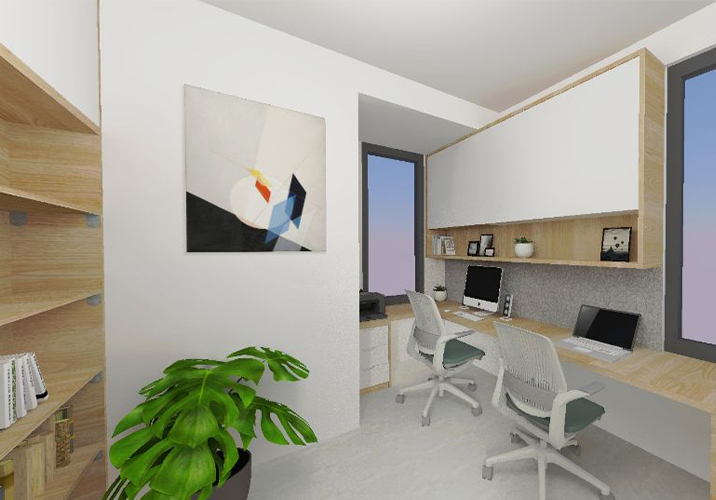Choosing between carpets can be tricky and with the range of colours and textures on the market, it can get overwhelming. The texture and colour you choose for your carpet will primarily depend on the way your space is used. In areas of high activity, durable fabrics will work best but in rooms that cater to children, a darker carpet will be preferable. Discover how to choose a carpet for your space based on the different styles and fibres available.
Different types of carpet available
Cut or loop
Carpets are either a cut pile or loop pile construction and both styles offer something different. The differences lie in the style, level and length of the yarn, but the material you choose will depend on the durability and ease of the maintenance you prefer.
In a loop carpet, the yarn is looped and doesn’t show external marks created by walking or vacuuming, making it ideal for areas with high foot traffic. On the other hand, the exposed yarn is cut and looped in a cut and loop yarn carpet. These carpets are more suitable for bedrooms, where foot traffic is quite low.
- Twist carpets: also known as ‘frieze’ carpets, are comprised of yarn twisted in different directions that create the appearance of depth and texture. As a cut pile style, twist carpets provide a comfortable and soft surface but are also long lasting and durable, making it the ideal option for households with pets. The textured look is currently trending and can complement modern home designs.

- Plush carpets: are level-cut piles that are luxurious options for the home, ensuring comfort and style. With consistent fibre lengths and a high-sheen surface, cut pile plush carpets are more prone to display temporary shades from vacuums and footprints. Textured plush carpets, however, have fibres twisted in different angles and effectively conceal vacuum or footprints making it an ideal option for high activity areas and people with busy lifestyles.

- Loop carpets: Loops of yarn can create a range of modern carpet finishes. Loop carpets referred to as Berber, are created with yarns that are looped back into the carpet and are generally made from nylon or olefin fibres. Level or multi-level loops are constructed with rows of looped yarns of the same or variant heights, depending on your preference and style.

Wool or nylon
In Australian homes, the most popular carpet selections are made of blends from nylon, wool or olefin (polypropylene). Choosing a carpet won’t depend on the fibre selection alone, but determining which fibres are best suited to your environment will help you make the right carpet choice.
Wool carpets can be a great addition to a space, feeling soft and luxurious. Wool is a natural and sustainable fibre, which is bound to keep you warm in winter and cool in the summer. As a resilient and easily dyed fibre, wool is also available in a range of styles to adapt to the look of your home. Textured or twist carpets can often trap dirt between fibres and will quickly absorb any liquid stains so the required maintenance should be considered prior to investing in a wool rug or carpet. The elasticity and resilience of wool also makes it a suitable option for high traffic spaces, while its durability and soft surface makes it a great choice for cooler climates.

Ingrid Powell from Choices Flooring, estimates that around 90% of all residential carpets are made from nylon, a durable and stain resistant fibre.
“Wool is the ultimate natural fibre when it comes to carpet whereas nylons and polypropylenes are manmade and have more manufactured properties included in their makeup,” she said.
Nylon fibres are either woven or made from sunken loops, creating a simple and compact texture. Nylon is cost effective for its durability and versatile range of colours and styles, and is highly resistant to abrasion. It is a synthetic fibre however so it is prone to emit off-gas.

Olefin fibres have a low absorbency rate. As a positive, this means olefin carpets are stain resistant but on the flip side, olefin is not easily dyed, providing limited style choices. Olefin carpets can be most useful for outdoor areas or spaces prone to spillage or liquid damage. Olefin is non-resilient and it will not regain its shape easily when exposed to weight or high activity areas.
Contact local carpet experts
Colour options
Take a moment to consider the space you intend to carpet as this will influence the style and fabric you choose. With pets or children about, carpets with lower maintenance are preferable and a dark charcoal or coffee coloured carpet will show less of the stains, but in small spaces, dark carpet colours can make the space appear smaller. When paired with white walls, lighter coloured carpets will draw your eyes outwards, giving the appearance of extra space, but can be a lot more difficult to clean or maintain.
Start by considering what mood or effect you wish to create with your carpet. For example, if you wish to add a homely touch to an empty space, you may consider opting for a neutral or warm tones carpet such as greys or soft pinks, to add an inviting allure to a space. A neutral colour carpet will also shift the focus away from the flooring and complement your furnishings. Alternatively, if you wish to open up a small and stuffy space, you might choose a carpet with whites or cool tones such as blues and greens, to make a room feel cooler and brighter.














